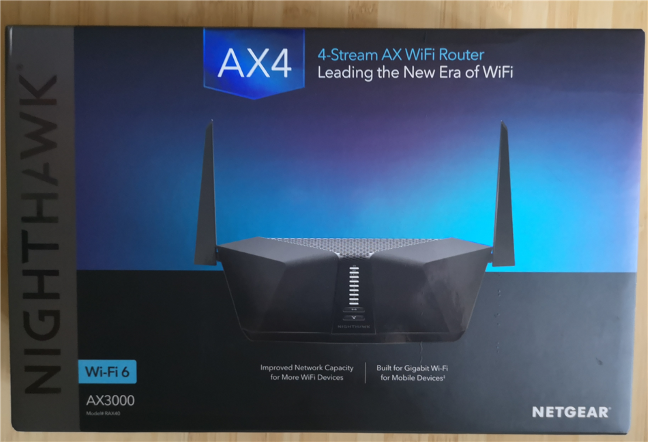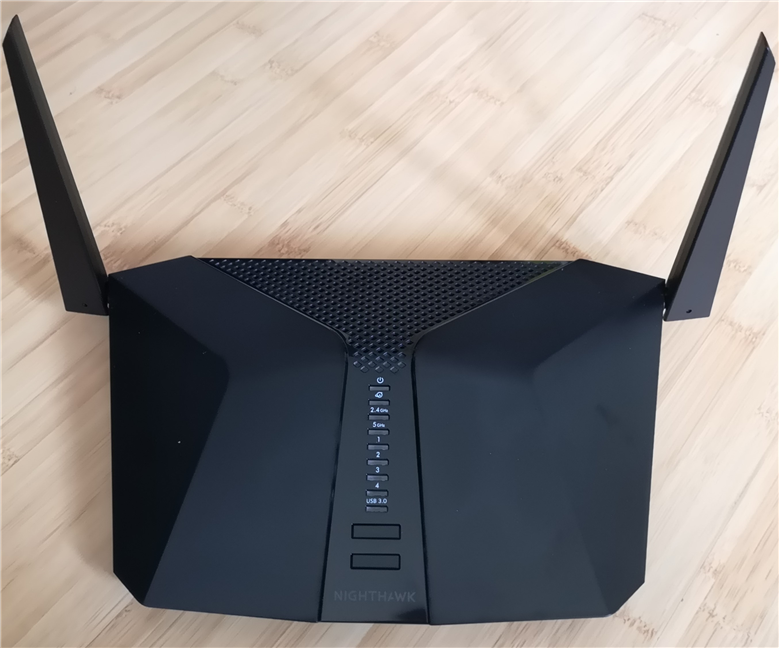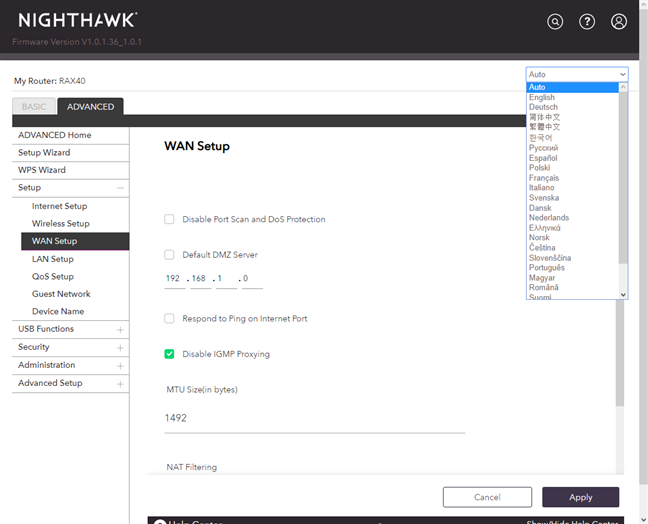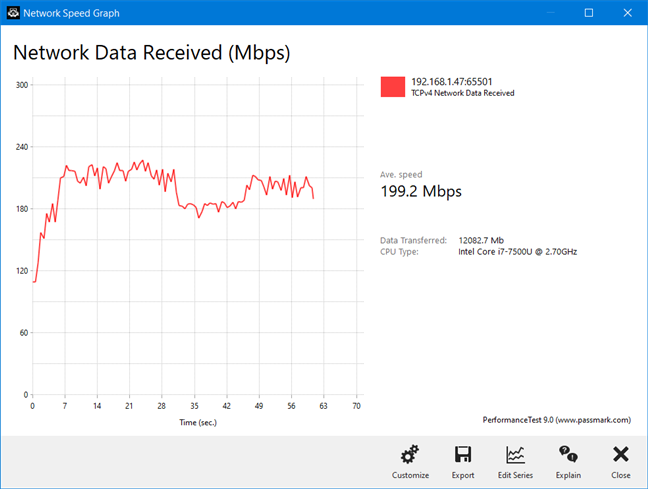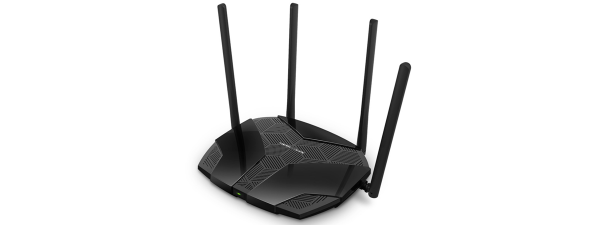
Netgear has launched several wireless routers with support for the new Wi-Fi 6 wireless standard. The most affordable in this line-up is the new NETGEAR Nighthawk AX4 (model RAX40), which, unlike its brothers, uses an Intel processor, instead of one made by Broadcom or Qualcomm. If you want to see what the NETGEAR Nighthawk AX4 dual-band wireless router has to offer, and whether it is a good fit for you, read this review:
NETGEAR Nighthawk AX4: Who is it good for?
NETGEAR Nighthawk AX4 is a great choice for the following types of users:
- People who want to invest in the Wi-Fi 6 standard and plan to buy devices with support for it
- Enthusiasts who want advanced firmware that offers complete control
- Users who want to control their home network using Amazon Alexa or Google Assistant
Pros and cons
There are many positives about the NETGEAR Nighthawk AX4:
- Support for the newest wireless standard - 802.11ax a.k.a Wi-Fi 6
- Netgear's cloud accounts are protected with two-step verification
- Sharing of USB devices is truly plug-and-play, thanks to the ReadySHARE feature
- You can set the router to update its firmware automatically, without manual intervention
- It is integrated both with Amazon Alexa and Google Assistant
- It can be mounted on walls
- Great multilingual support
There are some negatives to consider as well:
- The speed of the USB 3.0 port deserves improvement
- The WiFi experience on the 2.4 GHz may be faulty on some network clients (not all)
- Netgear's ecosystem of apps and services is confusing and needs to be simplified
Verdict
NETGEAR Nighthawk AX4 is part of the first wave of wireless routers on the market with support for the new Wi-Fi 6 (802.11ax) standard. Also, it is one of the most affordable routers with support for this technology, with less powerful hardware, fewer USB ports, and fewer advanced features. If you want to jump on the Wi-Fi 6 bandwagon, and you do not want to spend a crazy amount of money, NETGEAR Nighthawk AX4 is a router that you should take into consideration.
Unboxing the NETGEAR Nighthawk AX4 wireless router
NETGEAR Nighthawk AX4 comes in a black box with blue accents. On the top you see a picture of the router, and a few of its features mentioned. The product naming is a bit confusing, as the manufacturer refers to it as NETGEAR Nighthawk AX4 but also as AX3000 model RAX40.
On the sides of the box you find details about the technical specifications of this product and its capabilities. When you open the package, you find the following items inside: the router itself, the power adapter, an Ethernet CAT5e cable, the quick start guide, and the warranty.
The unboxing experience offered by NETGEAR Nighthawk AX4 is quick and pleasant. In the packaging, you get everything you need to set up and use the wireless router.
Hardware specifications and design
NETGEAR Nighthawk AX4 is a modern dual-band wireless router with support for the draft version of the Wi-Fi 6 (802.11ax) wireless standard. Its total theoretical maximum bandwidth is of 3000 Mbps, split as follows: 600 Mbps for the 2.4 GHz band, and 2400 Mbps for the 5 GHz band, when using the Wi-Fi 6 standard.
The router has an aggressive design, familiar to the Nighthawk brand. There are only two external antennas, and Netgear does not mention the existence of any internal antennas. On the top side of the router, there are the ventilation grids, several LEDs that signal the status of the router and its features, as well as two buttons for controlling the WiFi broadcast and the WPS feature.
On the back of the router, there is the Internet port, four Ethernet ports working at 1 Gbps, the power jack, the Reset and the Power buttons, a USB 3.0 port, and a button for controlling the LEDs on the top.
On the bottom of the router, there are two holes for mounting the router on walls, as well as some stickers with information about the product, and more ventilation grids that help cool the hardware inside.
Speaking of hardware: NETGEAR Nighthawk AX4 has a dual-core Intel PXB4395 processor, running at 800 MHz, 512 MB of RAM and 256 MB of storage space for the firmware and the apps that you install on it. When compared with other AX wireless routers, the hardware on this model is a bit more modest. Due to is lower specs, Nighthawk AX4 delivers only 2x2 MU-MIMO wireless transfers, instead of 4x4 or 8x8, like other wireless routers, that have more powerful hardware. Obviously, NETGEAR Nighthawk AX4 also works using the older Wi-Fi 5 and Wi-Fi 4 standards, as most people do not own devices that can use the new Wi-Fi 6 standard.
NETGEAR Nighthawk AX4 is an average-sized router, with 13.38 x 8.11 x 2.24 inches or 340 x 206 x 57mm in width x depth x height. It also weighs about 1.32 lb or 600 grams.
If you would like to learn more about the official specifications of this wireless router, go to this page: NETGEAR Nighthawk AX4 Specifications.
Setting up and using the NETGEAR Nighthawk AX4 wireless router
Setting up the NETGEAR Nighthawk AX4 wireless router can be done both from a PC, using a web browser, or from a smartphone, using the Nighthawk app for iOS and Android. This time we decided to change our approach and use the mobile app instead of the traditional browser-based setup. The Nighthawk app is not complicated to use, and it doesn't request many permissions on your mobile device, which is good. The setup wizard asks for your location and then whether you want to install a new router. After you connect your smartphone to the default WiFi emitted by the router, you can set the type of internet connection that you are using, and enter the appropriate connection details.
You then set the name and password for the WiFi in your home, set the admin password that you want to use (it would have been great to be able to set the username too), and answer some security questions that you can use to recover your password (when you forget it). The app checks for firmware updates, and, if any are available, it recommends that you perform the upgrade. It is a good approach. Unfortunately, the latest update that we received had some bugs that lowered WiFi performance, so we had to revert back to an older firmware version.
After the firmware update is finished, you can connect your router to your Netgear cloud account, so that you can remotely manage the router, even when you are not at home. One useful security precaution is that Netgear recommends that users enable two-step verification to protect their accounts, which is great. Other router manufacturers should emulate this approach. Then, you get to finally use the app to remote control your router. The app is simple to use but also very basic. You cannot perform any advanced configuration from it.
For that, you need to use a web browser on your PC, and log in to the router's administration user interface. This interface is split into two tabs: Basic and Advanced. The Basic tab has few options, and all are easy to configure.
The real fun is in the Advanced tab. There you can find all the configuration options that are available for your router. The user interface is available in many languages, and switching between them is easy. Also, most of the settings can be understood with ease, if you have a bit of knowledge about technology in general. However, the way the Advanced tab is organized, is not that well thought out, and you need some time to get used to the location of all the settings. For example, you get two different sets of wireless settings, both under Setup and Advanced Setup, which leads to confusion.
The Help documentation is easily accessible, as well as the Online Support options. But, unlike routers from other brands, the documentation is available online, not in the firmware of the router. Therefore, if your internet connection does not work, you cannot access the Help documentation and use it.
Another aspect that it is unique to Netgear is that, in order to use all the advanced features of the Nighthawk AX4, you need to install several apps, and set up accounts in more than one place. This ecosystem of apps, features and services is confusing to users, and more difficult to understand. Netgear should improve this, and give direct access to more advanced features straight from its firmware, like other manufacturers do. However, as a positive, we loved how truly plug-and-play the experience of connecting an external hard disk to the USB 3.0 port, and sharing with the network is.
After we were done setting up the NETGEAR Nighthawk AX4 router, we connected several devices to the network: two desktop PCs, a couple of laptops, one tablet, several smartphones, an Xbox One console, two smart plugs, one smart bulb, an intelligent robot vacuum cleaner, and a wireless printer. They all connected with ease, and we had no problems in sharing files and folders over the network. However, when we used the 2.4 GHz wireless band, we had an uneven experience. On some devices like our smartphones, everything was fast and smooth, while on our test laptop, the average speed was low, and wireless transfers were performed with high variability. To give you a perspective, look at the transfer made on the 2.4 GHz band, in a room separated from the router by one wall. It was rather disappointing, and Netgear should investigate this. We suspect that this may be caused by incompatibilities with some wireless network cards and specific drivers, as it is the case with other AX wireless routers from other brands.
Another transfer, made in the same room, on the 5 GHz band, was fast and stable, as you would expect from a router like the NETGEAR Nighthawk AX4. Performance on the 5 GHz band was fast and smooth, and we have no complaints about it.
If you want to see the details about the wireless performance of this router, and all the features that it has to offer, go to the next page of this review.


 24.06.2019
24.06.2019 